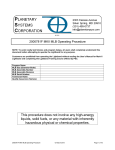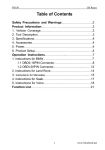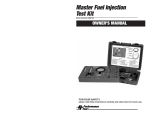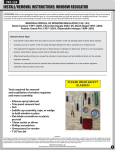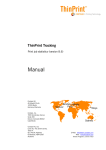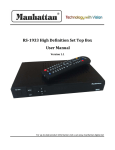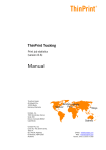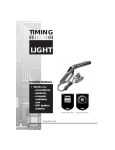Download FUEL INJECTION PRESSURE TESTER KIT
Transcript
#3640 FUEL INJECTION PRESSURE TESTER KIT Fuel © IEC 1997 Table of Contents Paragraph Title Page No. GENERAL INFORMATION 1.1 1.2 1.3 1.4 1.5 ABOUT THE TESTER ..................................................................... VEHICLES COVERED .................................................................... BEFORE YOU BEGIN ..................................................................... SAFETY PRECAUTIONS ................................................................ VEHICLE SERVICE MANUALS .................................................... 1-1 1-2 1-2 1-3 1-4 TESTING 2.1 2.2 GENERAL ......................................................................................... TEST PROCEDURES....................................................................... 2-1 2-2 WARRANTY AND SERVICE 3.1 3.2 i LIMITED ONE YEAR WARRANTY................................................ SERVICE PROCEDURES................................................................ 3-1 3-1 Fuel 1 General Information 1.1 ABOUT THE TESTER The Fuel Injection Pressure Tester Kit is designed to perform fuel pressure tests on most domestic and import cars and trucks. The tester saves you time and money by helping you test and troubleshoot fuel system problems which can affect your vehicle's performance and fuel economy. The tester can help you identify and diagnose: • • • • • Low fuel pump pressure Faulty fuel pressure regulator Leaking fuel injectors Clogged fuel filter Leaks in the fuel system 1.1.1 Fuel Injection Pressure Tester Kit Components (see Figure 1) Figure 1. Fuel Injection Pressure Tester Kit Components 1 6 9 10 8 7 2 5 3 4 1. Tester Gauge. Shows fuel pressure in system during test. 2. Relief Valve. Relieves pressure in the fuel system during and after testing. 3. Bleed-Off Hose. Drains bleed-off fuel into a suitable container. 4. Gauge Hose. High pressure hose with threaded female connector; connects to the vehicle's fuel system test port. 5. Tee Fitting. Universal fitting with built-in test port. Allows the tester to be used on some vehicles not factory-equipped with a test port (Schrader valve). Engine 1-1 1 6. Ford Adapter. Installs on the fuel system test port of Ford and some Chrysler vehicles to allow connection of the tester. 7, 8. Hose. 5/16" and 3/8" universal high-pressure hoses used in conjunction with tee fitting (5). 9, 10. Hose Clamp. High-pressure fuel line clamps used in conjunction with hoses (7, 8) and tee fitting (5). NOTE: The adapters provided with the tester are designed to facilitate the most common fuel injection system applications. Some vehicle applications may require additional tools or adapters to properly test the vehicle. Refer to your vehicle's service manual, and consult your auto parts dealer for the availability of these items. 1.2 VEHICLES COVERED 1.2.1 Domestic Vehicles (1980-98) • Dodge, Chrysler, Plymouth • Ford, Lincoln, Mercury • GMC, Chevrolet, Buick, Oldsmobile, Pontiac, Saturn, Cadillac • Jeep, Eagle Fuel System Type/Applications • All electronic fuel injection systems (port, sequential, multi-point, throttle body), which are equipped with a fuel pressure test port (Schrader valve) • All fuel injection systems (without a fuel pressure test port) equipped with flexible rubber fuel supply lines 1.2.2 Import Vehicles (1980-98) • Geo • Includes light trucks and vans • Isuzu • Excludes diesel • Mazda • Nissan • Subaru • Suzuki • Volkswagen 1.3 BEFORE YOU BEGIN • Fix any known mechanical problems before performing any test. WARNING: 1-2 Please be aware that fuel systems are UNDER PRESSURE AND HIGHLY FLAMMABLE. In addition to following all safety precautions, a basic understanding of fuel systems is necessary. Read this manual thoroughly to prevent accidents, personal injury and/or damage to your vehicle. • If a further understanding of fuel injection systems is necessary, many publications covering this topic are available. • Your vehicle’s service manual can give you specialized test procedures and repair methods which can make your job easier. READ YOUR VEHICLE’S SERVICE MANUAL. • Keep a pencil and paper handy to make notes and record test results. Fuel General Information a. Read and follow all safety precautions. b. Make sure the battery is fully charged and the vehicle has enough fuel in the tank. c. Perform a thorough underhood inspection. Check for loose or cracked electrical wiring, battery cables, ignition wires, fuel and/or vacuum lines. Perform necessary repairs and ensure the fuel system is leak-free. WIPE UP ANY FUEL LEAKS IMMEDIATELY. d. Verify all related fuses are in good condition. Verify integrity of all electrical component connections. e. For Ford vehicles ONLY: Make sure the inertia switch (the fuel system’s safety switch) is not tripped and is operating properly. (Refer to your vehicle’s service manual for location.) f. Check the vapor recovery system and fuel tank cap for proper operation. g. Make sure the intake (engine) vacuum is within original manufacturer’s specifications. h. If the engine does not start, refer to your vehicle’s service manual for proper diagnostic procedures. 1.4 SAFETY PRECAUTIONS • Read this manual COMPLETELY before performing any test procedures. • Always observe safety precautions whenever working on a vehicle. a. Always wear safety eye protection. b. Only work on your vehicle in a well-ventilated area. c. Put transmission in PARK (automatic transmission) or NEUTRAL (manual transmission). Set parking brake. d. Put blocks on the drive wheels. e. Release fuel system pressure before connecting test equipment or performing tests (refer to your vehicle’s service manual for procedures). f. Make sure the ignition is off before connecting or disconnecting any test equipment. g. Never connect the Fuel Injection Tester to any location other than those indicated in the test procedures (many air conditioning fittings resemble fuel injection test ports). h. Fuel and battery vapors are highly flammable. DO NOT SMOKE NEAR THE VEHICLE DURING TESTING. i. DO NOT attempt to use this tool on systems not covered in this manual. j. During testing, be careful to avoid fuel spills on hot engine parts. If spills occur or if leaks are present, turn ignition off IMMEDIATELY and correct the problem. WIPE UP FUEL SPILLS IMMEDIATELY. k. Avoid moving fan blades or any potentially moving parts. l. Avoid hot engine parts. Keep tools away from the battery to avoid possible shorting and sparks which could start a fire. m. In case of emergency, keep a fire extinguisher handy. MAKE SURE it is rated for fuel/electrical and chemical fires. Fuel n. NEVER leave the vehicle unattended during testing. o. Take care when working near ignition system components (coil, distributor cap, ignition wires, etc). These are all HIGH VOLTAGE areas. 1-3 1 p. When placing the bleed-off hose into a container to collect excess fuel, make sure the container is approved for gasoline. q. When working on vehicles equipped with airbags, follow all cautions and test procedures in your vehicle’s service manual to avoid accidental airbag deployment. r. Gasoline and gasoline additives are TOXIC. AVOID CONTACT OF GASOLINE WITH SKIN. Wear protective clothing and hand covering (approved latex gloves) when performing pressure tests. In case of contact with skin, WASH THE AREA IMMEDIATELY. 1.5 VEHICLE SERVICE MANUALS You MUST consult the manufacturer’s service manual for your vehicle BEFORE performing any test procedures. Contact your local car dealership, auto parts store, bookstore or public library for availability of these manuals. The following companies publish valuable repair manuals, including material that covers fuel injection systems and testing techniques. ■ Chek-Chart Publications 1515 Grandview Parkway, Sturtevant, Wisconsin 53117 Phone (800) 662-6277 ■ Haynes Publications 861 Lawrence Dr., Newbury Park, California 91320 Phone (805) 498-6703 ■ Mitchell International 9889 Willow Creek Rd., P. O. Box 26260, San Diego, California 92196-0260 Phone (619) 578-6550 ■ Motor Publications 5600 Crooks Rd., Troy, Michigan 48098 Phone (800) 426-6867 1.5.1 Factory Manuals ■ 1-4 Ford/General Motors Service Manuals Helm Inc. 14310 Hamilton Ave., Highland Park, Michigan 48203 Phone (800) 782-4356 Fuel General Information Fuel 1-5 2 2.1 GENERAL The tests outlined in this manual are for checking Throttle Body Fuel Injection (TBI) (see Figure 2) and Multi-port Fuel Injection (MFI) (see Figure 3) fuel system pressures with the engine running (key on, engine on) and without the engine running (key on, engine off). Engine running tests are performed with the engine at idle (unless otherwise noted). The adapter for testing GM vehicles with test ports is already installed on the end of the gauge hose, while the Ford adapter is separate. For Chrysler vehicles, depending upon application, either adapter may be used. Figure 2. Typical Throttle Body Fuel Injection (TBI) System THROTTLE BODY PRESSURE REGULATOR FLEXIBLE HOSE FUEL RETURN LINE FUEL PRESSURE LINE FUEL CAP TBI UNIT FUEL INJECTORS IN-LINE FUEL FILTER FUEL TANK IN-TANK FUEL PUMP PUMP INLET FILTER Figure 3. Typical Multi-Port Fuel Injection (MFI) System MANIFOLD VACUUM HOSE CONNECTION PRESSURE REGULATOR TEST PORT (SCHRADER VALVE) PULSE DAMPENER FUEL RETURN LINE FUEL INJECTORS FUEL PRESSURE LINE FUEL CAP FLEXIBLE HOSE IN-LINE FUEL FILTER PULSATOR FUEL TANK IN-TANK FUEL PUMP PUMP INLET FILTER Some fuel injection systems are not equipped with a test port (Schrader valve). In some cases, these systems may be tested using the tee adapter provided with the tester: 2-1 Fuel Testing • The tee adapter is suitable for use with most fuel injection systems equipped with rubber fuel hoses secured by fuel line clamps at the fuel rail or throttle body (see Figure 6). • The tee adapter is not suitable for use with fuel injection systems equipped with rigid, metallic or plastic fuel lines or connectors. 2.2 TEST PROCEDURES WARNING: Fuel injection systems are under high pressure. You MUST relieve system pressure before connecting the tester. REFER TO YOUR VEHICLE'S SERVICE MANUAL FOR PROCEDURES. • Before connecting the tester to the fuel system, apply a small amount of light grade household oil or lubricant to the o-rings located in the port adapters. • When attaching the gauge hose or adapters to test ports, make sure you use the proper adapter for your vehicle. TAKE CARE not to damage the threads on the test port. • • Wrap shop rags around fitting when connecting or disconnecting the tester. Have shop rags ready to clean up leaks or spills. 2.2.1 Testing Systems WITH Schrader Valve Test Ports (Typical TBI & MFI Systems) (see Figure 4) a. Relieve fuel system pressure BEFORE connecting tester (refer to your vehicle's service manual for procedures). Figure 4. Testing Systems With Schrader Valve Test Ports TESTER GAUGE RELIEF VALVE BLEED-OFF HOSE GAUGE HOSE FORD ADAPTER (FOR USE WITH FORD AND SOME CHRYSLER VEHICLES) (SCHRADER VALVE) DRAIN CONTAINER Fuel 2-2 2 b. Loosen the fuel tank cap to release any pressure from the fuel tank. c. MAKE SURE the ignition is off. Locate the fuel system’s test valve or port. Remove the protective cap. WARNING: d. The air conditioning test port looks similar to the fuel system test port. DO NOT CONFUSE THESE PORTS. Refer to your vehicle's service manual to ensure proper connections. Connect the tester to your vehicle’s fuel system: ■ For Ford and some Chrysler vehicles: Install the Ford port adapter on the throttle body or fuel rail test port, FINGER TIGHT ONLY, then connect the gauge hose to the adapter. ■ e. For GM and some Chrysler vehicles: Connect the gauge hose directly to the test port, FINGER TIGHT ONLY. Place bleed-off hose into an approved drain container. MAKE SURE the hose remains in the container until testing is complete. f. MAKE SURE all of the vehicle’s accessories (air conditioner, fan, radio, defroster, lights, etc.) are turned off. g. Turn ignition on and listen for fuel pump activation (most systems will activate the fuel pump circuit for approximately two seconds when the ignition is initially turned on to prime the fuel system). Check the test setup and MAKE SURE no fuel leaks are present. ■ NOTE: If fuel leaks ARE present, turn off ignition IMMEDIATELY and repair any leaks. BE SURE TO CLEAN UP FUEL SPILLS IMMEDIATELY. If your fuel system does not operate as described in step g, or if fuel system is not operating properly, refer to the manufacturer’s service manual for repair procedures or activation instructions. h. When the fuel pump has been activated in step g, the fuel system is pressurized. Verify the tester gauge indicates a system pressure which corresponds with the specifications provided in your vehicle’s service manual. If the fuel pressure is within vehicle manufacturer's specifications, proceed to step j. If pressure is not within manufacturer's specifications, proceed to step i. i. Turn ignition off and follow the test and repair procedures in your vehicle's service manual to correct the problem. After all necessary repairs have been completed, return to step g. j. Start and idle engine. RECHECK THE TEST SETUP FOR FUEL LEAKS. k. Read fuel pressure from the tester gauge. If the fuel pressure is within vehicle manufacturer's specifications, proceed to step m. If pressure is not within manufacturer's specifications, proceed to step l. l. Turn ignition off and follow the test and repair procedures in your vehicle's service manual to correct the problem. After all necessary repairs have been completed, return to step j. m. Turn ignition off. 2-3 n. MAKE SURE that the bleed-off hose is still routed to the drain container. Press and hold the relief valve to bleed off system pressure. Hold the relief valve until the tester gauge indicates 0 (see Figure 5). o. Shake the bleed-off hose to ensure all residual fuel has been expelled. Fuel Testing p. Wrap a shop rag around test port area to avoid fuel spray and to absorb excess fuel. CAREFULLY disconnect the gauge hose from the port adapter. NOTE: If installed, remove the Ford adapter from the vehicle's test port. q. Remove the bleed-off hose from the drain container and hold both gauge hoses over the container to let any remaining fuel drain. Store the tester in a well-ventilated area to dry completely. r. Recheck all fuel system connections, then start the engine. Check for any leaks and repair as necessary. NOTE: Figure 5 RELIEF VALVE The engine may crank for several seconds before restarting. 2.2.2 Testing Systems WITHOUT Schrader-Type Test Ports (TBI & MFI Systems) (see Figure 6) WARNING: Fuel injection systems are under high pressure. You MUST relieve system pressure before connecting the tester. REFER TO YOUR VEHICLE'S SERVICE MANUAL FOR PROCEDURES. Figure 6. Testing Systems Without Schrader Valve Test Ports TESTER GAUGE RELIEF VALVE GAUGE HOSE BLEED-OFF HOSE FUEL RETURN LINE FUEL PRESSURE LINE HOSE CLAMP ADAPTER HOSE HOSE CLAMP TEE FITTING HOSE CLAMP INLET HOSE DRAIN CONTAINER TESTING SYSTEMS WITHOUT SCHRADER VALVE TEST PORTS Fuel 2-4 2 WARNING: a. Relieve fuel system pressure BEFORE connecting tester (refer to your vehicle's service manual for procedures). b. Loosen the fuel tank cap to release any pressure from the fuel tank. c. Verify the ignition is off. Locate the fuel system’s inlet line (or hose) leading to the fuel rail or throttle body. (Refer to your vehicle’s service manual for locations.) d. CAREFULLY disconnect inlet fuel line (supply line) from system connection point. INLET MAY BE UNDER PRESSURE. Try to keep hoses in an upright position to avoid excess fuel leakage. BE SURE TO CLEAN UP FUEL SPILLS IMMEDIATELY. NOTE: On Throttle Body Injection (TBI) systems, the supply line connection is typically located at the throttle body. On Multiport Fuel Injection (MFI) systems, the supply line connection is typically located at the fuel rail. e. Connect the inlet fuel line (supply line) from the vehicle (the one removed in step d) to one end of the tee fitting. Push the hose on to the fitting as far as it will go and secure using a hose clamp. Tighten the hose clamp securely. f. Locate the two hose pieces included with the tester (there are two different size hose pieces). Select the hose piece which fits best on the open end of the tee fitting and on the injection system’s inlet fitting. Attach one end of the hose piece to the tee fitting. Push the hose on to the fitting as far as it will go and secure using a hose clamp. Tighten the hose clamp securely. Attach the other end of the hose piece to the injection system’s inlet fitting. Push the hose on to the fitting as far as it will go and secure using a hose clamp. Tighten the hose clamp securely (see Figure 6). g. Connect the gauge hose to the open fitting on top of the tee, FINGER TIGHT ONLY. h. Place the bleed-off hose into an approved drain container. MAKE SURE the hose remains in the container until testing is complete. i. MAKE SURE all of the vehicle’s accessories (air conditioner, fan, radio, defroster, lights, etc.) are turned off. j. Turn ignition on and listen for fuel pump activation (most systems will activate the fuel pump circuit for approximately two seconds when the ignition is initially turned on to prime the fuel system). Check the test setup and MAKE SURE no fuel leaks are present. ■ NOTE: k. 2-5 Systems without test ports require that fuel lines be removed or disconnected. Please be aware that these lines may be UNDER PRESSURE, and when removed could cause fuel spray and/or leakage onto hot engine parts. If fuel leaks ARE present, turn off ignition IMMEDIATELY and repair any leaks. BE SURE TO CLEAN UP FUEL SPILLS IMMEDIATELY. If your fuel system does not operate as described in step j, or if fuel system is not operating properly, refer to the manufacturer’s service manual for repair procedures or activation instructions. When the fuel pump has been activated in step j, the fuel system is pressurized. Verify the tester gauge indicates a system pressure which corresponds with the specifications provided in your vehicle’s service manual. If the fuel pressure is within vehicle manufacturer's specifications, proceed to step m. If pressure is not within manufacturer's specifications, proceed to step l. Fuel Testing l. Turn ignition off and follow the test and repair procedures to correct the problem. After all necessary repairs have been completed, return to step j. m. Start and idle engine. RECHECK THE TEST SETUP FOR FUEL LEAKS. n. Read fuel pressure from the tester gauge. If the fuel pressure is within vehicle manufacturer's specifications, proceed to step p. If pressure is not within manufacturer's specifications, proceed to step o. o. Turn ignition off and follow the test and repair procedures in your vehicle's service manual to correct the problem. After all necessary repairs have been completed, return to step m. p. Turn ignition off. q. MAKE SURE the bleed off-hose is still routed to the drain container. Press and hold the relief valve to bleed off system pressure. Hold the relief valve until the tester gauge indicates 0 (see Figure 7). r. Shake the bleed-off hose to ensure all residual fuel has been expelled. s. Wrap a shop rag around tee fitting area to avoid fuel spray and to absorb excess fuel. CAREFULLY disconnect the gauge hose from the tee fitting. Hold both the bleed-off hose and the gauge hose over the drain container to let any remaining fuel drain. Store the tester in a well-ventilated area to dry completely. t. Loosen hose clamps and remove the tee fitting and any additional hose pieces which were previously installed to perform testing. u. Reconnect the fuel inlet line (supply line) to it’s original connection point. MAKE SURE all hose clamps are reinstalled and tightened properly (refer to your vehicle’s service manual for proper connections, as necessary). v. Recheck all fuel system connections, then start the engine. Check for any leaks and repair as necessary. Figure 7 RELIEF VALVE NOTES: Fuel • • The engine may crank for several seconds before restarting. • The service life of the port adapter o-rings can be prolonged by applying a film of oil to them before storing. Shop rags which have been exposed to any flammable liquids or materials should be stored in an approved container to avoid hazardous conditions. 2-6 3 3.1 LIMITED ONE YEAR WARRANTY The Manufacturer warrants to the original purchaser that this unit is free of defects in materials and workmanship under normal use and maintenance for a period of one (1) year from the date of original purchase. If the unit fails within the one (1) year period, it will be repaired or replaced, at the Manufacturer's option, at no charge, when returned prepaid to the Service Center with Proof of Purchase. The sales receipt may be used for this purpose. All replacement parts, whether new or re-manufactured, assume as their warranty period only the remaining time of this warranty. This warranty does not apply to damage caused by improper use, accident, abuse, improper voltage, service, fire, flood, lightning, or other acts of God, or if the product was altered or repaired by anyone other than the Manufacturer's Service. The Manufacturer, under no circumstances shall be liable for any consequential damages for breach of any written warranty of this unit. This warranty gives you specific legal rights, and you may also have rights which vary from state to state. This manual is copyrighted with all rights reserved. No portion of this document may be copied or reproduced by any means without the express written permission of the Manufacturer. THIS WARRANTY IS NOT TRANSFERABLE. For service, send via U.P.S. (if possible) prepaid to Manufacturer. Allow 3-4 weeks for service/repair. 3.2 SERVICE PROCEDURES If you have any questions, please contact your local store, distributor or the Service Center. USA & Canada: (800) 544-4124 (9:00-4:00, Monday-Friday PST) All others: (714) 241-6802 (9:00-4:00, Monday-Friday PST) FAX: (714) 432-7910 (24 hr.) 3-1 Fuel Warranty and Service Fuel 3-2 INNOVA ELECTRONICS CORPORATION 17291 Mt. Herrmann Street Fountain Valley, CA 92708 Printed in Taiwan © IEC 1997 Fuel

















